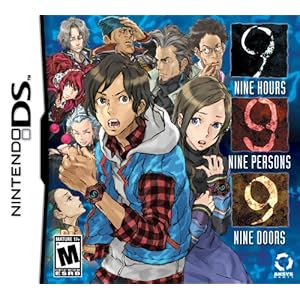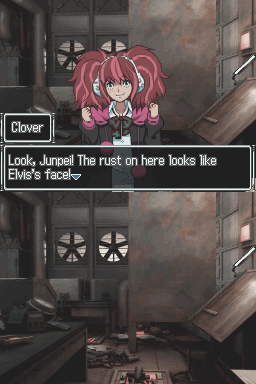 A game with enough plotlines and discussions on physics to make your brain explode and enough puzzles to stimulate your brain up to a large reveal at the end. This is what Virtue's Last Reward aspires to be. The sequel to 9 Hours 9 Persons 9 Doors in the Zero Escape series, Virtue's Last Reward places 9 participants in situations where they need to work together (or refuse to do so) and solve puzzles to escape through the number 9 door. Overall, Virtue's Last Reward delivers a well-told story, albeit a confusing one, with improved game mechanics from its predecessor.
A game with enough plotlines and discussions on physics to make your brain explode and enough puzzles to stimulate your brain up to a large reveal at the end. This is what Virtue's Last Reward aspires to be. The sequel to 9 Hours 9 Persons 9 Doors in the Zero Escape series, Virtue's Last Reward places 9 participants in situations where they need to work together (or refuse to do so) and solve puzzles to escape through the number 9 door. Overall, Virtue's Last Reward delivers a well-told story, albeit a confusing one, with improved game mechanics from its predecessor.Other characters are both old and new. Clover comes back for her third Nonary Game. There's also Alice, a friend of Clover's from right after 999 who has something against shirts. Luna is the fourth woman of the group, a quiet girl who just wants everyone to be nice to each other.
Why can't we be friends?!
Quark is the child of the group with a funky hat. He unfortunately suffers from being a plot device. I can say no more without spoilers. He's also unconscious for large portions of the game. When he's with you, he's really cute and quite funny with the next character, Tenmyouji. This old man is a bit grumpy from many years of a hard and lonely life, but he softens up around some characters. K is the large hunk of metal in the picture. He loses his memory as soon as the Nonary Game begins. The final and ninth character is Dio, a strange man who wears circus ringleader clothes.
But the best character in the whole game is that rabbit, Zero III -- or as the others call him, Zero Jr. This little guy helps you along in the beginning, but in a mocking tone. Even when he insults you, you can't stop loving him. (A close second favorite is a robot with a cockney accent.)
First off, Aksys continues to be a fantastic localization company. Their translation of the writing is smooth, perhaps even smoother than in 999 (but it unfortunately lacks the food-exploded body comparisons this time). There are plenty of rabbit puns for Zero Jr., giving the rabbit a personality just like everybunny. Aksys also isn't afraid to crack a few jokes in-game to the player.
You wound me, Aksys!
There are strengths and weaknesses in the writing of Virtue's Last Reward. There is a constant element of mystery motivating you to keep playing. Answers are teased to questions you didn't know you had, things are revealed before they make sense, and everything leads up to one OHMYGOD moment. And whereas 999's great reveal was on a personal level, the reveal in Virtue's Last Reward is on a massive scale. Neither is inherently better, but everyone has their own preferences. (999 is tragically beautiful in ways that VLR is not.)
However, the game drags on. There are long sequences of doors opening or watching yourself as a dot move from one room on a level to another room on another, and the locations of these rooms were not part of something larger, so forcing the player to view them over and over does nothing but frustrate the player. This game took me about 37 hours to finish completely. Several minutes could have been shaven off had it not been for those door opening/closing sequences. Also, does Sigma have to wait to vote ally/betray until half a second before the deadline every time?
Otherwise, the game's writing is quite subtle. Some things become overt from multiple playthroughs for different endings, making one character the typecast bad guy with no real complexity, but when X happens in A and not in B, you'll ask yourself why. Like 999, this is a game to discuss for hours with your friends, working out why something happened or didn't happen.
The character sprites, despite being in 3D, were less detailed than 999's 2D sprites. In some cases, they were downright disgusting. Characters only had a few poses each. Either stick to 2D sprites or give the 3D sprites fluidity. Treating a 3D sprite like a 2D in terms of posing doesn't flatter many characters.
The character designs were also rather unappealing. What exactly were Clover and Alice doing when they were abducted to lead them being in a pink leopard print bikini and a giant necklace that only covers one's nipples? Lotus had a reason for being dressed the way she did in 999, and while Clover and Alice hint at what they were doing, we don't really know.
The game's mechanics drive VLR like the dual-screen Nintendo DS was essential to 999's plot. VLR presents the player with a flowchart. When Sigma makes a decision to go through one door instead of another, a different reality occurs. You play through all of these realities to get to one final ending, gathering information in each one just as Junpei does in 999.
Thanks to this flowchart, you go through a different room in each timeline. And even though you start in the same first room and different endings have you going through the same first door, you don't need to repeat those puzzles like in 999. You can simply jump ahead to where you need to be: your next decision. And because there are so many little things happening in VLR, the flowchart makes it a little easier to manage what happens in each timeline. (But not too much easier.)
The Ally/Betray decisions are the best part of Virtue's Last Reward. What made this even better is that while my roommate and I played this game together, she was learning about the prisoner's dilemma for a class, which is precisely what the AB game is. If a group allies, then they all receive points. However, if one person betrays while another allies, the betrayer gains points while the person/pair who allied will lose points. And if everyone betrays, then no one gets points and everyone continues to hate each other. The point is to get 9 points and exit through the number 9 door. However, in such a stressful situation, ideals are lost. Would you choose to put your life in a stranger's hands?
But do you want to be THAT person who betrays everyone?
Virtue's Last Reward is available on both the PS Vita and the Nintendo 3DS. There should be a third game in the series as long as it gets the green light. In the meantime, I'll wrack my brain over this game and 999.
Note: There have been some reported bugs in the 3DS version where if you take too long in some rooms, the game will crash. I had no problems on my Vita version.
By the way, if you'd like to see how many notes you get to make while doing puzzles, check out the notes from my roommate and I. (It's not pictured, but there's a back side to each of those papers.)
Note: There have been some reported bugs in the 3DS version where if you take too long in some rooms, the game will crash. I had no problems on my Vita version.
By the way, if you'd like to see how many notes you get to make while doing puzzles, check out the notes from my roommate and I. (It's not pictured, but there's a back side to each of those papers.)


















